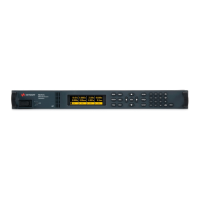Pin<n> - Selects a specific pin that is configured as a Trigger Input on the digital port. <n> specifies the
pin. The selected pin must be configured as a Trigger Input in order to be used as a trigger source (see
Using the Digital Port).
Use the following commands to select one of the available trigger sources:
Front Panel Menu Reference SCPI Command
Not available To selectBus triggers:
TRIG:TRAN:SOUR BUS, (@1)
To selectany digital pin as the trigger source:
TRIG:TRAN:SOUR EXT, (@1)
To selectan immediate trigger:
TRIG:TRAN:SOUR IMM, (@1)
To selectdigital pin 5 as the trigger:
TRIG:ACQ:SOUR PIN5, (@1)
Initiate and Trigger the Elog
When the power system is turned on, the trigger system is in the Idle state. In this state, the trigger
system is disabled, ignoring all triggers. The INITiate command enables the measurement system to
receive triggers. To initiate and trigger the Elog:
Front Panel Menu Reference SCPI Command
Not available To initiateand trigger the Elog:
INIT:ELOG, (@1)
TRIG:ELOG, (@1)
Alternatively, if the trigger source is BUS, you can also program a *TRG
or an IEEE-488 <get> command.
When triggered, the Elog starts placing data in the internal measurement buffer. Because the buffer is
only large enough to hold 20 seconds of accumulated measurement your PC application must
periodically retrieve (or fetch) the data from this buffer.
Periodically Retrieve the Data
Each FETCh command returns number of requested records of the data in the buffer and removes
them, making room available for more data. The Elog continues until it is aborted.
An Elog record is one set of voltage and current readings for one time interval. The exact format of a
record depends on which functions have been enabled for Elog sensing. If all functions are enabled,
then one record will contain the following data in the specified order:
Current average
Current minimum
Current maximum
Voltage average
Keysight N6700C Operating and Service Guide 147
4 Operating the Power System

